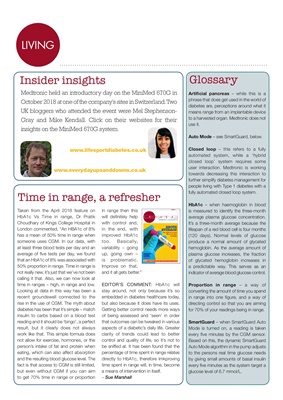
LIVINGLIVING
Taken from the April 2018 feature on
HbA1c Vs Time in range, Dr Pratik
Choudhary of Kings College Hospital in
London commented, "An HBA1c of 8%
has a mean of 50% time in range when
someone uses CGM. In our data, with
at least three blood tests per day and an
average of five tests per day, we found
that an HbA1c of 8% was associated with
50% proportion in range. Time in range is
not really new, it's just that we've not been
calling it that. Also, we can now look at
time in ranges - high, in range and low.
Looking at data in this way has been a
recent groundswell connected to the
rise in the use of CGM. The myth about
diabetes has been that it's simple - match
insulin to carbs based on a blood test
reading and it should be 'bingo', a perfect
result, but it clearly does not always
work like that. This simple formula does
not allow for exercise, hormones, or the
person's intake of fat and protein when
eating, which can also affect absorption
and the resulting blood glucose level. The
fact is that access to CGM is still limited,
but even without CGM if you can aim
to get 70% time in range or proportion
in range then this
will definitely help
with control and,
in the end, with
improved HbA1c
too. Basically,
variability - going
up, going own -
is problematic.
Improve on that,
and it all gets better."
EDITOR'S COMMENT: HbA1c will
stay around, not only because it's so
embedded in diabetes healthcare today,
but also because it does have its uses.
Getting better control needs more ways
of being assessed and 'seen' in order
that outcomes can be tweaked in various
aspects of a diabetic's daily life. Greater
clarity of trends could lead to better
control and quality of life, so it's not to
be sniffed at. It has been found that the
percentage of time spent in range relates
directly to HbA1c, therefore imkproving
time spent in range will, in time, become
a means of intervention in itself.
- Sue Marshall
Glossary
Time in range, a refresher
Artificial pancreas - while this is a
phrase that does get used in the world of
diabetes are, perceptions around what it
means range from an implantable device
to a harvested organ. Medtronic does not
use it.
Auto Mode - see SmartGuard, below.
Closed loop - this refers to a fully
automated system, while a 'hybrid
closed loop' system requires some
user interaction. Medtronic is working
towards decreasing this interaction to
further simplify diabetes management for
people living with Type 1 diabetes with a
fully automated closed loop system.
HbA1c - when haemoglobin in blood
is measured to identify the three-month
average plasma glucose concentration.
It's a three-month average because the
lifespan of a red blood cell is four months
(120 days). Normal levels of glucose
produce a normal amount of glycated
hemoglobin. As the average amount of
plasma glucose increases, the fraction
of glycated hemoglobin increases in
a predictable way. This serves as an
indicator of average blood glucose control.
Proportion in range - a way of
converting the amount of time you spend
in range into one figure, and a way of
directing control so that you are aiming
for 70% of your readings being in range.
SmartGuard - when SmartGuard Auto
Mode is turned on, a reading is taken
every five minutes by the CGM sensor.
Based on this, the dynamic SmartGuard
Auto Mode algorithm in the pump adjusts
to the persons real time glucose needs
by giving small amounts of basal insulin
every five minutes as the system target a
glucose level of 6.7 mmol/L.
Medtronic held an introductory day on the MiniMed 670G in
October 2018 at one of the company's sites in Switzerland. Two
UK bloggers who attended the event were Mel Stephenson-Gray
and Mike Kendall. Click on their websites for their insights on the
MiniMed 670G system.
Insider insights
www.lifesportdiabetes.co.uk
www.everydayupsanddowns.co.uk